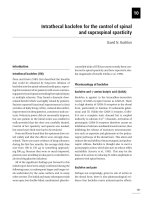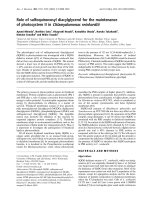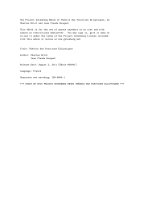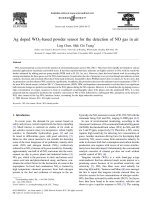Alternative Processing Technologies for the Control of Spoilage Bacteria in Fruit Juices and Beverages
Bạn đang xem bản rút gọn của tài liệu. Xem và tải ngay bản đầy đủ của tài liệu tại đây (3.9 MB, 21 trang )
4
Alternative Processing
Technologies for the
Control of Spoilage
Bacteria in Fruit Juices and
Beverages
Purnendu C. Vasavada
CONTENTS
Introduction
Control of Microbial Contamination
Preventive Measures in the Orchard
Washing
Preservatives
Pasteurization
Nonthermal Alternative Processing Technologies
High Pressure Processing
Pulsed Electric Field
Ultraviolet Light
Irradiation
Microwaves
Summary
Acknowledgment
References
INTRODUCTION
Fruit juices and fruit-based beverages are mildly acidic products, usually
containing fermentable sugars, organic acids, vitamins, and trace elements,
and are subject to contamination by and growth of a variety of spoilage
organisms, notably yeasts and molds. Recent reports of outbreaks of illness
TX110_book Page 73 Tuesday, May 6, 2003 9:21 AM
© 2003 by CRC Press LLC
caused by the consumption of fruits or fruit juices contaminated with patho-
genic microorganisms such as
Salmonella, E. coli
O157:H7, and
Cryptosporidium
1–4
have caused great concern. In the aftermath of these
outbreaks, the U.S. Food and Drug Administration (FDA) has issued a
guidance document to minimize microbial food safety hazards in fresh and
minimally processed fruits and vegetables and mandated a Hazard Analysis
and Critical Control Point (HACCP) program to achieve a 5-log reduction
of pathogenic organisms.
5
The FDA also issued regulations dealing with the
warning label on any unpasteurized juices that have not received a 5-log
reduction process and recently, published the Juice HACCP Þnal rule on
January 19, 2001.
6,7
CONTROL OF MICROBIAL CONTAMINATION
Microbial contamination of fruit can occur at all stages of growth, harvesting,
storage, and processing. The surfaces of fresh fruits are often contaminated
with yeasts and molds. The use of over-mature, damaged, or fallen fruit
contaminated with manure from grazing animals has been implicated in
Salmonella
and
E. coli
O157:H7 outbreaks. Control of microbial contami-
nation of fruit and fruit juice involves care at all stages of production,
including preharvest practices of planting, growing of fruit, harvesting, post-
harvest handling, washing, and cooling and storage.
P
REVENTIVE
M
EASURES
IN
THE
O
RCHARD
Contamination of fruits with feces of animals such as deer,
8
seagulls,
9
and
cattle and other ruminants
10
in the orchard by direct or indirect contact should
be prevented, and fertilizing orchards with manure should be avoided.
11
Using “drops” and damaged fruit increases the potential for microbiological
contamination, including contamination with
E. coli,
and therefore should
be avoided.
11–13
Another important source of
E. coli
O157:H7 infections is
drinking water. Waterborne transmission of
E. coli
O157:H7 as a source of
infection in domestic animals is a concern to human health as well. Wang
and Doyle
14
reported that
E. coli
O157:H7 is a hardy pathogen that can
survive for long periods of time in water, especially at cold temperatures. In
an outbreak,
E. coli
O157:H7 was recovered from multiple water sources,
including a borehole, a standpipe, and water stored in the home.
15
Precautions
should be taken when using untreated water for washing purposes.
W
ASHING
Washing, mechanical scrubbing, and the use of chemical sanitizers may
result in considerable reduction in surface contamination (see Table 4.1).
Peroxyacetic acid (1280 ppm) was effective in accomplishing more than a
TX110_book Page 74 Tuesday, May 6, 2003 9:21 AM
© 2003 by CRC Press LLC
TABLE 4.1
Effects of Different Chemicals in Reducing Bacteria on the Surface of Fruits
Chemicals/ Disinfectants Concentration
Type of Bacteria
(Inoculum) Sample
Log
10
Reduction
Pathogenic Bacteria
Acetic acid 2–5%
5%
E. coli
O157:H7 Strawberry
Apple
1.6
3.1
Peroxyacetic acid (Tsunami 100) 80 ppm
80 ppm
a
1280 ppm
b
E. coli
O157:H7 Apple 2.6
3
5.5
Tween 80 100–200 ppm
E. coli
O157:H7 Strawberry 1.1–1.2
Sodium phosphate 2–5%
E. coli
O157:H7 Strawberry 1.6–1.9
Hydrogen peroxide
(H
2
O
2
)
1–3%
3%
6%
E. coli
O157:H7
E. coli
O157:H7
Salmonella chester
Strawberry
Tomato
Apple — on skin (cut)
Apple — on stem and calyx (cut)
1.2–2.2
4
3–4
1–2
Chlorine dioxide (Oxine) 5 ppm
80 ppm
E. coli
O157:H7 Apple 3
4.5
Sodium hypochlorite (NaOCl) 100–200 ppm
200 ppm
1.76%
E. coli
O157:H7
S. chester
Strawberry
Apple
Apple (cut)
1.3
2.1
1–2
Calcium hypochlorite (CaOCl) 36%
S. chester
Apple (cut) 1–2
Chlorine phosphate buffer (Agclor
310 [200 ppm]/Decco buffer 312)
200 ppm
3200 ppm
E. coli
O157:H7 Apple 3
4.5
(continued)
TX110_book Page 75 Tuesday, May 6, 2003 9:21 AM
© 2003 by CRC Press LLC
TABLE 4.1 (CONTINUED)
Effects of Different Chemicals in Reducing Bacteria on the Surface of Fruits
Chemicals/ Disinfectants Concentration
Type of Bacteria
(Inoculum) Sample
Log
10
Reduction
Phosphoric acid 0.3%
E. coli
O157:H7 Apple 2.9–2.3
Trisodium phosphate 2%
S. chester
Apple 1–2
Produce wash solution A mixture of water, oleic
acid, glycerol, ethanol,
potassium hydroxide,
sodium bicarbonate, citric
acid, and distilled
grapefruit oil
S.
population (spp.)
(
S. agona,
S. enteritidis,
S. gaminara,
S. montevideo,
S. typhimurium
)
Tomato 2–4
Combination treatment
(acetic acid followed by hydrogen
peroxide)
5%
3%
E. coli
O157:H7 Apple 2.4–2.5
Nonpathogenic Bacteria
Hydrogen peroxide
(H
2
O
2
) (50–60ûC)
Hydrogen peroxide
(H
2
O
2
) + acidic surfactants
(50–60ûC)
(5%)
E. coli
Apple 2.5
3–4
TX110_book Page 76 Tuesday, May 6, 2003 9:21 AM
© 2003 by CRC Press LLC
Sodium hypochlorite (NaOCl) 200 ppm
E. coli
ATCC 25922
E. coli
ATCC 25922
E. coli
ATCC 23716
E. coli
ATCC 11775
Enterobacter aerogenes
Apples
Apples (half)
0.5
1.9
1.4
1.7
2.0
a
Recommended sanitizer concentration.
b
16 times the recommended concentration.
Adapted from references 9, 18, 23–25.
TX110_book Page 77 Tuesday, May 6, 2003 9:21 AM
© 2003 by CRC Press LLC
5-log reduction of
E. coli
O157:H7 on apple surface. A 4.5-log reduction of
E. coli
O157:H7 was obtained using chlorine phosphate buffer (3200 ppm)
and chlorine dioxide (80 ppm). Hydrogen peroxide (5% H
2
O
2
) was less
effective in reducing
E. coli
levels; however, addition of acidic surfactants
(50–60ûC) caused a 3- to 4-log reduction of
E. coli
on apple.
Failure to wash fruits properly before processing is among the
main
reasons for contamination in fruit juice. Washing and brushing fruit before
the juicing step is common in juice processing. According to one industry
survey, 98% of orchards surveyed washed apples before crushing, 18% used
a detergent-based fruit wash, 37% used sanitizer after washing, and 64%
employed brushing in conjunction with washing.
11
Winniczuk (1994)
17
showed that the maximum cleaning efÞcacy of most fruit wash systems
produces a 90 to 99% reduction in the population of microorganisms on a
citrus fruit surface under optimum pilot plant situations, whereas less-than-
optimum conditions may result in only a 60% reduction of fruit surface
microßora. However, washing trials using water showed only a 1- or 2-log
reduction in many experimental research studies.
18,19
Conventional washing practices using chlorine and brushing only may
be partially effective in controlling microbial contamination.
9
The pathogens
contaminating the fruit are not always located on the surface
20
and are not
always distributed uniformly, thus limiting the effectiveness of surface treat-
ments. Kenney et al. (2001)
19
suggested that cells may be sealed within
naturally occurring cracks and waxy cuts in platelets. These cells may be
protected from disinfection and subsequently released when apples are eaten
or pressed for cider production. Also, the 5-log inactivation of pathogens on
the surface may not necessarily result in requisite reduction of pathogens in
juice.
21,22
For example, Pao and Davis (1999)
22
reported that an application
of a 5-log inactivation treatment to oranges resulted in a 1.5- to 2.0-log
reduction in juice. They also demonstrated that an overall 5-log inactivation
of
E. coli
on the surface of oranges resulted in only a 3.5-log reduction in
the juice. Treatment of fruit and vegetables with disinfectants is more effec-
tive in removing pathogenic microorganisms than washing with water alone
but still not reliable enough to completely eliminate pathogenic bacteria.
P
RESERVATIVES
Another approach for controlling contamination, especially in processed
product, is the use of preservatives. In an industry survey, just 12% of
producers reported using preservatives; among them, 60% used potassium
sorbate and 40% used sodium benzoate. Potassium sorbate has little effect
in reducing
E. coli
O157:H7 in cider.
26
Although sodium benzoate was
more effective than potassium sorbate on
E. coli
O157:H7,
26
the bacteria
survived in refrigerated cider containing 0.1% sodium benzoate for 21
TX110_book Page 78 Tuesday, May 6, 2003 9:21 AM
© 2003 by CRC Press LLC
days.
26
Similarly, citric and malic acids had no bactericidal effect.
27
Comes
and Beelman (2002)
27
indicated that a 5-log reduction of
E. coli
O157:H7
in apple cider can be achieved using a preservation treatment involving
the addition of fumaric acid (0.15%, w/v) and sodium benzoate (0.05%,
w/v) to apple cider, followed by holding the cider at 25ûC for 6 h before
24 h of refrigeration at 4ûC. The Þnal pH after the addition of fumaric acid
and sodium benzoate was between 3.2 and 3.4. The authors suggested that
this intervention process is cost effective and could easily be incorporated
into HACCP systems that are currently mandated for processing of fruit
and vegetable juices by the FDA.
27
The use of preservatives may change heat resistance of
E. coli
O157:H7.
For example, potassium sorbate and sodium benzoate reduce the heat resis-
tance of
E. coli
O157:H7, but benzoate is about eight times more effective
than sorbate.
28,29
Dock et al. (2000)
29
stated that addition of sodium benzoate
(0.2%) increased the z-value from about 6 to 26ûC. This increase may result
in a longer 5-log reduction time (higher 5D-values) at higher temperatures
(i.e., 70ûC) in cider with benzoate as compared to cider without additives.
This has profound implications because processors who add benzoate to
cider before processing may obtain less than the 5-log reduction of
E. coli
O157:H7 that would have occurred without any benzoate addition. Induction
of acid resistance can also have wide-ranging effects on the ability of bacteria
to resist other stresses such as heating, antimicrobials, and exposure to
ultraviolet light.
22,30
While preservatives may have some merit for extending
product shelf life, they cannot be relied upon to eliminate pathogens from
fruit juice or cider.
The FDA guideline for minimizing microbiological hazards emphasizes
Þve major areas:
1. Water quality
2. Manure/bio-solids
3. Worker hygiene
4. Field, facility, and transport sanitation
5. Trace back
By considering the potential sources of contamination and implementing
an effective combination of good agricultural and manufacturing practices
(GAPs) related to apple juice/cider production, growers can minimize the
risk of microbiological contamination.
Several effective alternative processing technologies have been developed
for controlling microbial contamination, especially contamination with
pathogenic microorganisms. These include pasteurization, high hydrostatic
pressure (HHP) or ultra-high pressure (UHP), ultraviolet (UV), and pulsed
TX110_book Page 79 Tuesday, May 6, 2003 9:21 AM
© 2003 by CRC Press LLC
TABLE 4.2
Time–Temperature Conditions for Pasteurization of Apple Cider/Juices in the U.S.
Method Process Conditions Sample Target Organism
Log
10
Reduction
Heat pasteurization 71.1ûC/>3 sec Single-strength apple juice,
orange juice, white grape juice
E. coli
O157:H7
Salmonella
spp.
Listeria monocytogenes
≥
5
71.1ûC/6 sec Apple cider
E. coli
O157:H7
(cocktail)
Salmonella
spp. (cocktail)
L. monocytogenes
(cocktail)
5
71.1ûC/160ûF
for 11 min
or
76.7ûC/170ûF for 2 min
Apple cider produced from Red
Delicious apples
E. coli
O157:H7
(cocktail)
Salmonella
spp. (cocktail)
L. monocytogenes
(cocktail)
5
Wisconsin
recommendation:
68.1ûC for 14 sec
Apple cider
E. coli
O157:H7
(cocktail)
Salmonella spp. (cocktail)
L. monocytogenes
(cocktail)
5
Adapted from Liao, C.H. and Sapers, G.M., J. Food Prot., 63, 876–883, 2000; Mazzotta, A.S., J. Food Prot., 64, 315–320, 2001.
TX110_book Page 80 Tuesday, May 6, 2003 9:21 AM
© 2003 by CRC Press LLC









